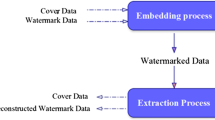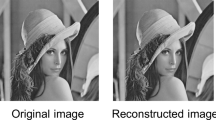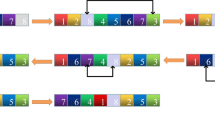Abstract
This paper proposes an adaptive watermarking scheme for e-government document images. The adaptive scheme combines the discrete cosine transform (DCT) and the singular value decomposition (SVD) using luminance masking. As a core of masking model in the human visual system (HVS), luminance masking is implemented to improve noise sensitivity. Genetic algorithm (GA), subsequently, is employed for the optimization of the scaling factor of the masking. Involving a number of steps, the scheme proposed through this study begins by calculating the mask of the host image using luminance masking. It is then continued by transforming the mask on each area into all frequencies domain. The watermark image, following this, is embedded by modifying the singular values of DCT-transformed host image with singular values of mask coefficient of host image and the control parameter of DCT-transformed watermark image using Genetic Algorithm (GA). The use of both the singular values and the control parameter respectively, in this case, is not only to improve the sensitivity of the watermark performance but also to avoid the false positive problem. The watermark image, afterwards, is extracted from the distorted images. The experiment results show the improved adaptive performance of the proposed scheme is in resistant to several types of attacks in comparison with the previous schemes; the adaptive performance refers to the adaptive parameter of the luminance masking functioned to improve the performance or robustness of an image from any attacks.




Similar content being viewed by others
References
Amiri MD, Danyali H, Zahir-Azami B (2010) An adaptive robust and multiresolution image watermarking for progressive wavelet image coding, 6th International Conference on Wireless Communications Networking and Mobile Computing (WiCOM). pp 1
Aslantas V (2007) An SVD based digital image watermarking using genetic algorithm. Int J Electron Commun: 1–4
Bao P, Ma X (2005) Image adaptive watermarking using wavelet domain singular value decomposition. IEEE Trans Circuits Syst Video Technol 15(1):96–102
Barni M, Bartolini F, Piva A (2001) Improved wavelet-based watermarking through pixel-wise masking. IEEE Trans Image Process 10(5):783–791
Belkacem S, Dibi Z, Bouridane A (2007) A masking model of HVS for image watermaking in the DCT domain. IEEE Int Conf Electron, Circ Syst: 330
Benhocine A, Laouamer L, Nana L, Pascu AC (2013) New images watermarking scheme based on singular value decomposition. J Inf Hiding Multimedia Signal Process 4(1):9–18
Carballeira P (2012) Analysis of pixel-mapping rounding on geometric distortion as a prediction for view synthesis distortion, Proceeding of 3DTV-Conference: the true vision - capture, transmission and display of 3D video (3DTV-CON) 2012, pp 1–4
Coello Coello CA, Toscano Pulido G (2001) A micro-genetic algorithm for multi objective optimization. Proc Genet Evolut Comput Conf
Cui L, Li W (2011) Adaptive multiwavelet-based watermarking through JPW masking. IEEE Trans Image Process 20(4):1047–1060
Genetic Algorithms http://www.cs.ucc.ie/~dgb/courses/tai/notes/handout12.pdf
Hamed M, Hossein Khosravi R, Mohammad R, Akbarzadeh T (2010) A new adjustable blind watermarking based on GA and SVD, Proceeding of International Conference on Innovations in Information Technology (IIT), pp 6–10
He X, Chang S (2011) An adaptive image watermarking algorithm based on neural network. Int Conf Intell Comput Technol Autom 2:408
Himanshu H, Rawat S, Raman B, Bhatnagar G (2011) DCT and SVD based new watermarking scheme, 3rd International Conference on Emerging Trends in Engineering and Technology (ICETET), pp 146–151
Hoi-Yu Tong H (1997) A perceptually adaptive JPEG coder, master thesis, University of Toronto
Huang HC, Chen YH (2009) Genetic fingerprinting for copyright protection of multicast media. Soft Comput 13(4):383–391
Huang HC, Chu CM, Pan JS (2009) The optimized copyright protection system with genetic watermarking. Soft Comput 13(4):333–343
Huang C-H, Wu J-L (2000) A watermark optimization technique based on genetic algorithms. Proc SPIE 3971
Kang X, Huang J, Zeng W (2008) Improving robustness of quantization-based image watermarking via adaptive receiver. IEEE Trans Multimedia 10(6):953–959
Kumar Sharma D, Kumar Pathak V, Sahu GP (2007) Digital watermarking for secure e-government framework Computer Society India, pp 182–191
Kuo S-s, Johnston JD (2002) Spatial noise shaping based on human visual sensitivity and its application to image coding. IEEE Trans Image Process 11(5):509–517
Lai CC, Huang HC, Tsai CC (2009) A digital watermarking scheme based on singular value decomposition and micro-genetic algorithm. Int J Innov Comput Inf Control 5(7):1867–1873
Li Q, Yuan C, Zhong Y-Z (2007) Adaptive DWT-SVD domain image watermarking using human visual model. Int Conf Adv Commun Technol 3:1947
Lim SB (2010) Human visual system, http://www.siongboon.com/projects/2010-08-22/electronicballast/HumanVisualSystem.pdf
Ma X, Shen X (2008) A novel blind grayscale watermark algorithm based on SVD, Proceeding of International Conference on Audio, Language and Image Processing (ICALIP), shanghai, pp 1063–1068
Mairgiotis AK, Galatsanos NP (2008) New additive watermark detectors based on a hierarchical spatially adaptive image model. IEEE Trans Inf For Sec 3(1):29–37
Naiss I (2013) Computable bounds for rate distortion with feed forward for stationary and ergodic sources. IEEE Trans Inf Theory 59(2):760–781
Pappas TN, Safranek RJ, Chen J (2005) Perceptual criteria for image quality evaluation. In: Bovik AC (ed) Hand book of image and video processing, 2nd edn. Academic Press, San Diego, United States of America
Rosiyadi D, Horng S-J, Fan P, Wang X, Khan MK, Pan Y (2012) An efficient copyright protection scheme for e-government document images. IEEE Multimedia 19(3):62–73
Si H, Li C-T Maintaining information security in e-government through steganology, Department of Computer Science, University of Warwick, Coventry CV4 7AL, UK
Sing K (2011) edge detector, http://yumnamkirani.hpage.us/edge_detection_74376639.html
Verma A, Tapaswi S (2009) A novel reversible visible watermarking technique for images using Noise Sensitive Region Based Watermark Embedding (NSRBWE) approach, IEEE EUROCON ‘09, pp 1374
Voloshynovskiy S, Pereira S, Pun T, Eggers JJ, Su JK (2001) Attacks on digital watermarks: classification, estimation based attacks, and benchmarks. IEEE Commun Mag 39(8):118–126
Wang J (2008) Design of e-government security system based on information security model. Inf Manag, Innov Manag Ind Eng 2: 359–362, ISBN: 978-0-7695-3435-0, 19–21
White GB, Jones S (2007) Minitrack E-government information security, system sciences, 2007. HICSS 2007. 40th Annual Hawaii International Conference on, E-ISBN: 0-7695-2755-8, pp 97–97
Xue S, Teng X (2007) Adaptive blind watermarking based on improved noise sensitivity. Fourth Int Conf Fuzzy Syst Knowl Discov 4:731–734
Yan Y, Wei C, Li S (2009) Block-based adaptive image watermarking scheme using just noticeable difference. IEEE Int Work Imaging Syst Tech: 377–380
Zhang X, Han G, Zou K, Li W, Li B (2007) An effective mechanism based on watermark for e-government information security. Int Conf Converg Inf Technol- IEEE:580–585
Zhao F, Liu G, Ren F (2009) Adaptive blind watermarking for JPEG2000 compression domain, 2nd International Congress on Image and Signal Processing, pp 1
Zhu S-m, Liu J-m (2008) Adaptive watermarking scheme in hybrid DWT-DCT transform based on human visual system. Int Symp Knowl Acquis Model: 668
Acknowledgments
We would like to thank the Department of Computer Science and Information Engineering, National Taiwan University of Science & Technology for giving the permission to commence this thesis in the first instance, to do the necessary research work and to use departmental data.
Author information
Authors and Affiliations
Corresponding author
Additional information
This work was supported in part by the National Science Council under contract number NSC-99-2916-I-011-002-A1, and it was also partially supported by the 111 Project under the grant No. 111-2-14 and One Hundred Person Project 2012, Sichuan Province.
Rights and permissions
About this article
Cite this article
Horng, SJ., Rosiyadi, D., Fan, P. et al. An adaptive watermarking scheme for e-government document images. Multimed Tools Appl 72, 3085–3103 (2014). https://doi.org/10.1007/s11042-013-1579-5
Published:
Issue Date:
DOI: https://doi.org/10.1007/s11042-013-1579-5




